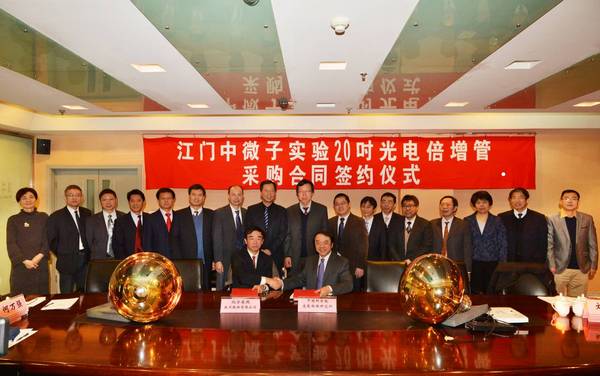Key Components Ordered for JUNO Experiment
A procurement contract on 20-inch photomultiplier tubes (PMTs) for the Jiangmen Underground Neutrino Observatory (JUNO) was signed at the Institute of High Energy Physics (IHEP) on December 16.This is the largest single batch of procurement of goods since the foundation of the institute.
According to the contact, China North Industries Group Corporation (NORINCO Group)will produce 15,000 high-quality 20-inch photomultiplier tubes (PMTs) for the JUNO experiment.
PMTs are a common component of particle physics and nuclear physics experiments, and their main role is to convert optical signals to electrical signals. For earlier experiments, large-diameter photomultiplier tubes could only be produced by overseas companies.
During the construction of the Daya Bay Reactor Neutrino Experiment in 2008, IHEP initiated pre-research on photomultiplier tubes, aiming to achieve localization of the PMT production.
Over a four-year collaboration process, the project team overcame a number of technical difficulties, including production of photo cathodes with high quantum efficiency, microchannel plates, and large-size bulbs and packaging technology for optoelectronic devices in vacuum.
Eventually, a sample tube was developed and entered mass production. Its key technical characteristics, including quantum efficiency, collection efficiency and single photoelectron peak ratio, are of the world-class level required for the JUNO experiment.
The Jiangmen Underground Neutrino Observatory (JUNO) is a multipurpose neutrino experiment designed to determine the neutrino mass hierarchy and precisely measure oscillation parametersby detecting reactor neutrinos from the Yangjiang and Taishan Nuclear Power Plants, using a 20-thousand-ton liquid scintillator detector of unprecedented 3% energy resolution (at 1 MeV) 700metersunderground.In addition, it can observe supernova neutrinos, study atmospheric, solar and geo-neutrinos, and perform exotic searches.

Key Components Ordered for JUNO Experiment (Image by IHEP)